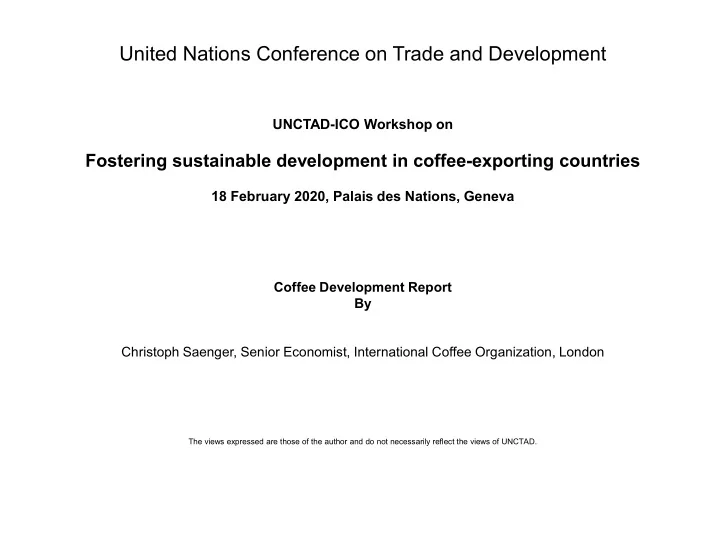

United Nations Conference on Trade and Development UNCTAD-ICO Workshop on Fostering sustainable development in coffee-exporting countries 18 February 2020, Palais des Nations, Geneva Coffee Development Report By Christoph Saenger, Senior Economist, International Coffee Organization, London The views expressed are those of the author and do not necessarily reflect the views of UNCTAD.
Dr Christoph Sänger UNCTAD-ICO Workshop Palais des Nations Geneva, 18 February 2020
Download at: http://www.internationalcoffeecouncil.org/
COFFEE AND ECONOMIC DEVELOPMENT
COFFEE IS LIVELIHOOD SOURCE FOR 25 MILLION FARMERS
COFFEE IS PRODUCED IN COUNTRIES THAT RANK LOW IN GDP AND HDI Non-Coffee Coffee 120,000 100,000 GDP per capita PPP 80,000 60,000 40,000 20,000 0 0.3 0.4 0.5 0.6 0.7 0.8 0.9 1.0 Human Development Index (HDI)
RELATIONSHIP OF 1% CHANGE IN COFFEE PRICE AND… Rural employment rate 3% Supply of protein of 10% animal origin* Agriculture value added 1% % of GDP Undernourishment * -9% Poverty headcount ratio -4% at $1.90 a day (a) ECONOMIC AND SOCIAL OUTCOMES (b) FOOD SECURITY Political stability 0.08 index GINI index -0.02 (c) POLITICAL STABILITY AND SOCIAL COHERENCE * Results are significant for countries which are highly dependent on coffee (share of coffee in total export value) Results are statistically significant at least at the 10% level.
CURRENT STATE OF THE COFFEE MARKET
INTERNATIONAL COFFEE PRICE* DROPPED BY 28% 250 200 US cents/lb 150 -28% 100 10-yr average 50 Feb-10 Aug-11 Feb-13 Aug-14 Feb-16 Aug-17 Feb-19 * ICO Composite Indicator
Root causes of the decline in coffee prices • Fundamental factors of demand and supply: overproduction • Non-fundamental factors: – Financialisation of futures markets – Exchange rate volatility – Mergers and acquisitions in the coffee industry à potential shift in market power
PRODUCTION COSTS ARE ON THE RISE 270 in local currency, 2006=100 Index of per-hectare cost Brazil 220 Costa Rica 170 Colombia El Salvador 120 70 2006 2008 2010 2012 2014 2016
ACHIEVING EQUITABLE GROWTH
COMPARISON OF GROWTH IN COFFEE CONSUMPTION BY REGION (INDEX OF VOLUME) 450 5.5% Index of coffee consumption 300 3.1% 1990/91=100 3.2% 1.7% 150 1.1% 0 1990/91 1999/00 2008/09 2017/18 Asia* Central America & Mexico South America Africa Traditional markets
OVER 90% OF COFFEE EXPORTED IN GREEN FORM Green Roasted Soluble 120 8.2% 0.3% million 60-kg bags 5.9% 80 0.1% 91% 40 94% 0 1994-1998 2014-2018
KEY AREAS FOR ACTION
CONSULTATIVE PROCESS IDENTIFIED KEY AREAS FOR ACTION • 50 potential solutions • Considered: o Barriers to implementation o Potential impact o Trade-offs • Leading actors: o Producers o Industry o Governments and international organizations o Public-private partnerships
Lead actors Solutions (according to barriers to implementation and potential impact) Low barrier / Medium High barrier / Narrow-scaled impact Wide-scaled impact A. Solutions to address price levels and demand-supply imbalances Producers • Investment in farm • Income diversification • Alternative livelihoods profitability and sustainability Market • Market promotion • Full traceability, supply actors • Producer support services chain partnerships • Price and premium management • Community development, landscape management Public sector • Sustainable public • Supply management by • Direct income transfers and procurement reduction of hectares • Differentiated taxes and tariffs international • Market promotion under coffee production • Rural infrastructure • Regulation on quality • Landscape management development organizations assurance and social & • Basic services e.g. • Land tenure reform environmental practices healthcare and education • Promotion of alternative uses • Investments in R&D of coffee • Supply management by international production and export quota
Lead actors Solutions (according to barriers to implementation and potential impact) Low barrier / Medium High barrier / Narrow-scaled impact Wide-scaled impact B. Solutions to address issues related to price volatility Producers • Physical strategies • Hedging strategies Market • Contract farming • Floor prices, access to actors hedging services Public sector • Farmgate price-setting in • Purchase guarantees • Modifications to futures and relation to export price • National strategic buffer exchange international stock management • Price stabilisation funds • International coordination of organizations buffer stocks C. Solutions to address risk and value distribution in the value chain Producers • Product differentiation, • Roasting at origin / value • Branding aggregation and marketing addition Market • Purchase of certified • Full traceability and • Decoupling sourcing strategy actors coffee, premiums supply chain partnerships from futures markets • No unfair trading practices • Price and premium management • Pre-finance Public sector • Upgrade existing market • Observatory for costs, • Farmgate price-setting in and information systems prices, margins relation to export price international • Benchmarks of production • Export auctions • Anti-trust regulation and living costs • Regulation on due organizations diligence and unfair trading practices
Priority actions – increasing value addition at origin • Improving coffee quality and adopting of VSS to enable producers to tap in high-value market segments / reduce costs & increase competitiveness • Improving quality requires investment at farm level and post-harvest processing (e.g. wet mills) • Create enabling environment for investments and FDI • Remove tariff and non-tariff trade barriers (tariff escalation) to boost processing at origin
Priority actions – foster sustainable sourcing practices • Finding optimal mix between company action, pre- competitive initiatives and government policies • Company level: – Long-term contracts (sharing of value & risk) – ’Flow of intangibles’ (credit, technical assistance, etc.) • Industry initiatives – Joint sustainability objectives, broad impact • Government policies and regulation – Creating a level playing field – Smart regulation
In collaboration with
Thank you
Recommend
More recommend